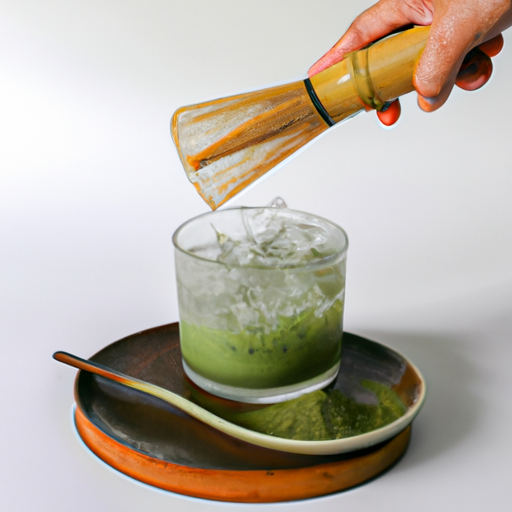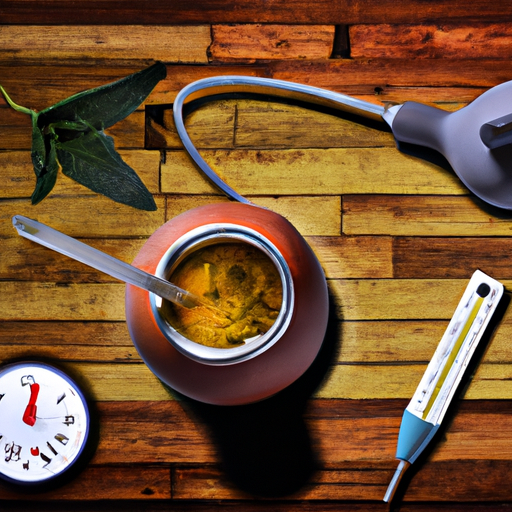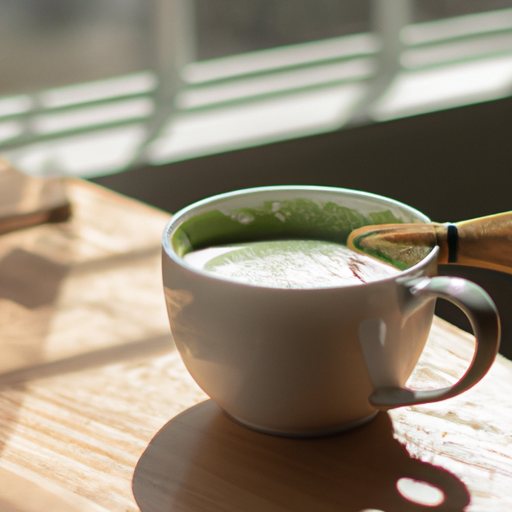I never imagined myself turning into a matcha aficionado.
The thought of drinking something green and bitter didn’t sound appealing to me at first.
But after trying it for the first time, I was hooked.
Not only is matcha packed with health benefits, but it also has a unique taste that can be enjoyed in various ways.
One of my favorite ways to enjoy matcha is through iced matcha, especially during the summer months.
Making iced matcha at home might seem intimidating at first, but it’s actually quite simple once you have all the right ingredients and tools.
In this article, I’ll guide you through the steps on how to make perfect iced matcha every time.
From preparing your matcha to serving it in style, I’ve got you covered so that you can enjoy a refreshing glass of iced matcha from the comfort of your own home.
So let’s get started!
Key Takeaways
- Using ceremonial grade matcha powder and proper preparation techniques are important for a smooth texture and vibrant green color.
- Adding ice and refrigerating the iced matcha is crucial for a refreshing drink while maintaining its quality and taste.
- Customizing iced matcha with fruit-infused or herb-infused ice cubes, sweeteners, and flavorings allows for endless possibilities according to preference.
- High-quality matcha powder and brewing at the right temperature between 160°F and 175°F (70°C – 80°C) are crucial for perfect iced matcha that provides health benefits and a unique taste.
Gather Your Ingredients
You’ll need to grab all the necessary ingredients for your homemade iced matcha, so head on over to your pantry and fridge!
You’ll want to start with a high-quality matcha powder. I recommend going for ceremonial grade matcha powder as it has a smooth texture and a vibrant green color that will make your iced matcha look and taste amazing.
Next up is sweetener – you can choose from various options depending on your preference. If you want natural sweeteners, then honey or maple syrup are great choices. Alternatively, you can use artificial sweeteners like stevia or xylitol if you’re looking for low-calorie options. Keep in mind that some sweeteners may affect the flavor of the drink, so it’s best to experiment with different types until you find one that suits your taste buds.
Now that we’ve gathered our ingredients let’s move on to preparing our matcha. To do this, we’ll need some hot water and a whisk. But don’t worry; it’s not as complicated as it sounds!
In the next section, I’ll guide you through step by step on how to prepare your iced matcha at home using these ingredients.
Prepare Your Matcha
Oddly enough, you don’t want to just dump the matcha powder into the pitcher and hope for the best. Proper preparation is key to making a delicious iced matcha at home.
First, select a high-quality matcha powder that suits your taste preferences.
Once you have selected your desired matcha powder, it’s time to prepare it for mixing. Start by sifting the powder to remove any clumps or lumps that may affect its texture when mixed with water. Then, add a small amount of hot water (about 2 ounces) to your matcha bowl or pitcher and whisk vigorously in an ‘M’or ‘W’motion until a frothy foam forms on top.
When preparing your matcha for iced drinks, there are several whisking techniques you can use depending on your preference. For a smoother consistency, try using circular motions with your whisk rather than the traditional back-and-forth motion. If you prefer a stronger flavor profile, increase the amount of matcha powder used while reducing the water ratio slightly.
Now that our matcha has been properly prepared and whisked to perfection, it’s time to move on to our next step: adding ice!
Add Ice
Adding ice is the perfect way to cool down your matcha and enjoy a refreshing summer drink. Before adding ice, make sure that your prepared matcha has cooled down to room temperature. This is important because pouring hot matcha over ice can cause it to melt too quickly, diluting the flavor.
To add ice, you have two options: ice cubes or crushed ice. If you prefer large pieces of ice that will slowly melt and keep your drink chilled for longer, go for ice cubes. On the other hand, if you want a slushier consistency with more surface area touching your tongue (which can enhance the taste), opt for crushed ice.
Once you’ve added your preferred type of ice, give it a quick stir with a spoon or straw to distribute evenly.
Next up is mixing and chilling!
Mix and Chill
So now that I’ve added ice to my matcha, it’s time to mix and chill.
First, I’ll use a whisk or spoon to thoroughly mix the matcha powder with the water and ice until it becomes frothy.
Then, I’ll transfer the mixture to the refrigerator to let it chill for a few minutes before enjoying my refreshing iced matcha.
Mixing Matcha and Ice
Now that you’ve got your matcha and ice ready, let’s mix them together to create a refreshing drink that will cool you down in no time!
To start, grab a shaker or a blender. If you’re using a shaker, add 1-2 teaspoons of matcha powder into the container along with some cold water (about ¼ cup). Stir it until all the clumps are gone. Then, add ice cubes into the shaker and shake vigorously for about 30 seconds until everything is well-combined.
If you’re using a blender, add 1-2 teaspoons of matcha powder along with some cold water (about ¼ cup) into the container. Blend on low speed for about 10 seconds until everything is incorporated. Next, add ice cubes into the blender and blend on high speed for another 20-30 seconds until everything is smooth and creamy.
Now that your matcha and ice have been mixed well together, it’s time to refrigerate your drink to keep it cold and fresh.
Refrigerating Your Iced Matcha
To keep your chilled matcha drink fresh, place it in the refrigerator for a while. Storing matcha properly is important to maintain its quality and taste.
Once you’ve mixed your matcha with ice and water, transfer it into a glass bottle or jar with an airtight lid. This will prevent any air from getting in and oxidizing the matcha, which can lead to a bitter taste.
Keeping fresh matcha is key to enjoying its unique flavor profile. Make sure to refrigerate your iced matcha for at least an hour before serving, so it can chill properly without diluting further.
Alternatively, you can try out different iced matcha recipes that use milk or other flavors for added variety. These alternatives also offer different storage options, as milk-based drinks should be kept cold but don’t necessarily need to be refrigerated in an airtight container like traditional iced matcha drinks do.
With your chilled and fresh iced matcha ready, let’s move on to how you can serve it!
Serve Your Iced Matcha
When it’s time to serve your iced matcha, don’t forget to add a splash of milk or cream for an extra touch of luxury. Presentation is key when it comes to serving matcha, and garnishing options are endless. You can add a slice of lemon or lime, fresh fruit, mint leaves, or even edible flowers for a pop of color.
To take your iced matcha presentation game up a notch, consider serving it in unique glassware such as mason jars or champagne flutes. This adds an element of elegance and makes the experience feel more special. Another option is to use decorative straws that complement the overall aesthetic.
Here are some examples of garnishing options and presentation ideas:
| Garnish Options | Presentation Ideas |
|---|---|
| Lemon/Lime Slice | Mason Jars |
| Fresh Fruit | Champagne Flutes |
| Mint Leaves | Decorative Straws |
| Edible Flowers |
Adding milk or cream and garnishments will elevate your iced matcha experience. Presentation is key when it comes to enjoying this antioxidant-rich beverage. In the next section, we’ll explore different variations of iced matcha that you can try at home.
Variations of Iced Matcha
You’ll love exploring the different variations of iced matcha, each offering a unique twist on this delightful drink.
One way to add some flavor to your iced matcha is by infusing it with fruit. Try adding sliced lemon or lime for a refreshing citrus taste, or experiment with berries like strawberries or raspberries for a sweet and fruity kick.
Another option is to mix in some fruit juice, such as pineapple or peach, to give your matcha an extra burst of flavor. If you prefer your iced matcha on the sweeter side, there are many different sweeteners you can use. Honey and agave nectar are popular choices, both offering a natural sweetness that complements the earthy flavor of matcha.
For those who prefer a more decadent treat, try adding a splash of vanilla syrup or caramel sauce for a truly indulgent experience. With so many ways to customize your iced matcha, there’s no limit to what you can create!
Whether you prefer it fruity and tangy or rich and sweet, there’s sure to be a variation that suits your taste buds perfectly. And best of all? Matcha is packed with health benefits that make it an excellent choice for any time of day.
Benefits of Drinking Matcha
If you’re looking for a delicious and healthy beverage, consider adding matcha to your daily routine. This vibrant green tea has been enjoyed in Japan for centuries and is now becoming increasingly popular worldwide. One of the reasons why matcha stands out from other teas is because it’s made by grinding whole tea leaves into a fine powder, which means you consume the entire leaf when drinking it.
With that said, let’s explore some of the health benefits associated with drinking matcha. Firstly, matcha is packed full of antioxidants called catechins, which help protect cells from damage caused by free radicals. Additionally, matcha contains caffeine and an amino acid called L-theanine that work together to boost energy levels while promoting relaxation and focus at the same time.
Moreover, some studies suggest that regular consumption of matcha may lower blood pressure, reduce inflammation in the body and improve brain function.
To fully enjoy these health benefits of matcha, it’s essential to brew it correctly using high-quality ingredients and proper brewing techniques. For example, always use water that is just below boiling point (around 80°C) as this will prevent the tea from becoming bitter. Also, be sure to sift your matcha powder before whisking it with hot water to ensure there are no clumps or lumps in your drink.
Incorporating a cup of freshly brewed matcha into your daily routine can provide numerous health benefits while also being a tasty treat. Now that we’ve explored some of these benefits, let’s move on to discuss tips on how to make perfect iced matcha at home!
Tips for Making Perfect Iced Matcha
To enjoy a refreshing and vibrant summer drink, simply blend together your favorite fruit with chilled matcha tea, creating a delicious smoothie that’s perfect for sipping by the pool. However, it all starts with having high-quality matcha powder and brewing it at the right temperature.
Matcha quality is crucial to achieving a full-bodied flavor and bright green color in your iced matcha. Look for ceremonial-grade or premium-grade matcha from reputable sources. When it comes to brewing matcha for iced drinks, it’s important to use slightly higher temperatures than when making hot tea. This helps extract more of the catechins and other beneficial compounds found in matcha.
The ideal temperature range is between 160°F and 175°F (70°C – 80°C). Anything hotter than that can result in bitter-tasting matcha. Once you’ve brewed your matcha tea, it’s time to add some ice cubes and flavorings of your choice.
There are many variations of ice cubes you can use such as fruit-infused or herb-infused ones which can add an extra layer of flavor to your drink while keeping it cold without diluting the taste. Flavorings like honey, lemon juice, or coconut milk also work well with iced matcha, giving you endless possibilities for customizing your drink according to your preference.
Frequently Asked Questions
What are the health benefits of matcha?
Matcha is often referred to as the "superhero of teas"due to its numerous health benefits. It contains high levels of antioxidants, which help to protect cells from damage caused by free radicals.
Additionally, matcha has been found to boost metabolism and aid in weight loss. One study even found that drinking matcha can increase fat burning during exercise by up to 25%.
Matcha also contains L-theanine, an amino acid that promotes relaxation and reduces stress levels without causing drowsiness. Compared to regular green tea, matcha offers a more concentrated dose of these beneficial compounds since it is made from whole tea leaves ground into a fine powder.
Incorporating matcha into your daily routine can be a simple way to support overall wellness and improve your health.
Can I use regular green tea instead of matcha for this recipe?
Regular tea alternatives can be used instead of matcha for this recipe, but the flavor will differ. Matcha has a unique taste that is earthy and slightly bitter, while regular green tea is milder in flavor. However, using regular green tea may allow for more experimentation with flavor variations by adding different fruits or sweeteners to complement the tea’s taste.
It’s important to note that the health benefits associated with matcha may not be present in regular green tea due to differences in processing and preparation methods. Overall, while using regular green tea as a substitute is possible, it will result in a different taste profile and potential loss of some health benefits.
How long can I store leftover matcha in the fridge?
When it comes to storing matcha, it’s important to keep in mind its shelf life. Matcha powder can last for up to six months if stored properly in an airtight container in the refrigerator.
However, once the container has been opened, the shelf life decreases significantly and should be consumed within three to four weeks. It’s also recommended to avoid storing matcha in direct sunlight or high temperatures as this can cause oxidation and spoilage.
To ensure the freshness of your matcha, it’s best to buy small amounts at a time and use them up quickly. In short, proper storage is key when it comes to extending the shelf life of your matcha powder.
Do I need a special whisk to prepare matcha?
When it comes to preparing matcha, a whisk is typically the tool of choice for achieving that frothy, smooth texture. However, there are alternatives to using a whisk if you don’t have one on hand.
One option is to use a fork or small wire whisk to break up any clumps in the matcha powder before adding water. Another alternative is to use a blender or electric frother for an even smoother consistency.
It’s important to note that while these options may work, they may not produce the same level of froth or viscosity as a traditional bamboo whisk. Ultimately, finding the right method and tools for preparing matcha without a whisk will depend on personal preference and experimentation.
Can I add sweeteners or milk to my iced matcha?
Yes, you can definitely add sweeteners or milk to your iced matcha to alter the flavor according to your preferences. Some popular sweeteners that go well with matcha include honey, agave syrup, and stevia. You can also experiment with different types of milk such as almond milk, coconut milk, or oat milk to create a creamier texture and enhance the overall taste of your iced matcha.
Additionally, there are other matcha flavoring ideas that you can consider adding to your drink like vanilla extract or cinnamon powder. Ultimately, it’s all about finding what works best for you and creating a personalized recipe that satisfies your taste buds.
Conclusion
Well, that’s it! I hope this guide has inspired you to try making iced matcha at home. It’s an easy and refreshing way to enjoy the many health benefits of matcha.
Plus, you can customize your drink with different types of milk or sweeteners to suit your taste. Coincidentally, I just made myself a glass of iced matcha while writing this conclusion.
As I take a sip, I’m reminded of how delicious and energizing it is. So why not give it a try? With just a few simple steps, you can enjoy the taste and health benefits of this ancient Japanese tea in the comfort of your own home.
Happy sipping!










